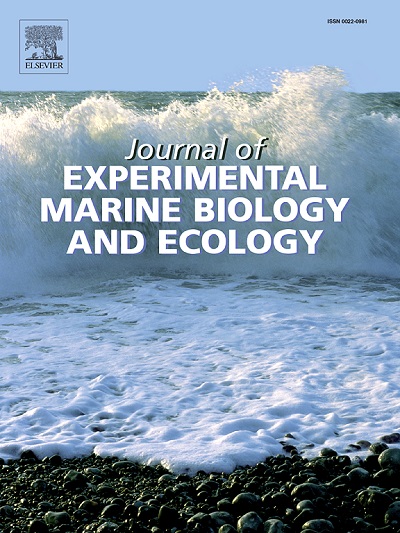Intrinsic factors affecting predator failure in crab-gastropod encounters and their implications for repair scar frequencies
IF 1.8
3区 生物学
Q3 ECOLOGY
Journal of Experimental Marine Biology and Ecology
Pub Date : 2025-01-01
DOI:10.1016/j.jembe.2024.152069
引用次数: 0
Abstract
Repair scars result from sublethal predator damage which is regrown, permanently recording predator-prey encounters. Although interactions between crabs and gastropods are well studied, it is not clear under what conditions these encounters lead to the generation of repair scars. As failed attacks generate repair scars, here, we use arena experiments to investigate intrinsic factors affecting the likelihood of predator failure using the crab, Cancer productus, and two of its common gastropod prey, Nucella ostrina and Tegula funebralis. Regression models indicate that C. productus was 44 % more likely to fail in encounters with T. funebralis than those with N. ostrina, which may be due to differences in shell strength and shape. In addition, encounters with T. funebralis were much longer in duration than those with N. ostrina, particularly for large prey attacked by small predators. Predator size had a direct effect on attack outcomes, particularly for T. funebralis, and the long duration of encounters suggests that in natural settings, extrinsic factors could potentially have large effects on failure rates. Field data show that T. funebralis populations tend to have greater repair frequencies than do coexisting N. ostrina. We propose that differences in repair frequency between T. funebralis and N. ostrina at the same location are likely due to intrinsic factors. However, repair scar frequencies may also reflect the density of small predators, as repair scars may primarily result from small crabs, which are also more likely to be interrupted by extrinsic factors in natural settings.
影响蟹腹足动物遭遇捕食失败的内在因素及其对修复疤痕频率的影响
修复疤痕是由亚致命的捕食者伤害造成的,它会再生,永久记录捕食者与猎物的相遇。尽管螃蟹和腹足类动物之间的相互作用已经得到了很好的研究,但尚不清楚在什么条件下这些接触会导致修复疤痕的产生。由于失败的攻击会产生修复疤痕,在这里,我们使用竞技场实验来研究影响捕食失败可能性的内在因素,实验对象是蟹、巨蟹和两种常见的腹足类猎物——ostrina Nucella和Tegula funebralis。回归模型表明,产弧菌与产弧菌的碰撞失败率比与玉米螟的碰撞失败率高44%,这可能是由于壳强度和形状的差异。此外,与灰顶棘球绦虫相遇的时间要比与鸵鸟棘球绦虫相遇的时间长得多,特别是对于被小型捕食者攻击的大型猎物。捕食者的体型对攻击结果有直接的影响,特别是对于T. funebralis,而长时间的遭遇表明,在自然环境中,外部因素可能对失败率有很大的潜在影响。野外资料显示,与共存的玉米螟相比,灰齿螟种群的修复频率更高。我们认为,在相同的位置上,灰顶棘球绦虫和玉米螟棘球绦虫修复频率的差异可能是由内在因素引起的。然而,修复疤痕的频率也可能反映了小型捕食者的密度,因为修复疤痕可能主要是由小螃蟹造成的,在自然环境中,小螃蟹也更容易受到外部因素的干扰。
本文章由计算机程序翻译,如有差异,请以英文原文为准。
求助全文
约1分钟内获得全文
求助全文
来源期刊
CiteScore
4.30
自引率
0.00%
发文量
98
审稿时长
14 weeks
期刊介绍:
The Journal of Experimental Marine Biology and Ecology provides a forum for experimental ecological research on marine organisms in relation to their environment. Topic areas include studies that focus on biochemistry, physiology, behavior, genetics, and ecological theory. The main emphasis of the Journal lies in hypothesis driven experimental work, both from the laboratory and the field. Natural experiments or descriptive studies that elucidate fundamental ecological processes are welcome. Submissions should have a broad ecological framework beyond the specific study organism or geographic region.
Short communications that highlight emerging issues and exciting discoveries within five printed pages will receive a rapid turnaround. Papers describing important new analytical, computational, experimental and theoretical techniques and methods are encouraged and will be highlighted as Methodological Advances. We welcome proposals for Review Papers synthesizing a specific field within marine ecology. Finally, the journal aims to publish Special Issues at regular intervals synthesizing a particular field of marine science. All printed papers undergo a peer review process before being accepted and will receive a first decision within three months.

 求助内容:
求助内容: 应助结果提醒方式:
应助结果提醒方式:


